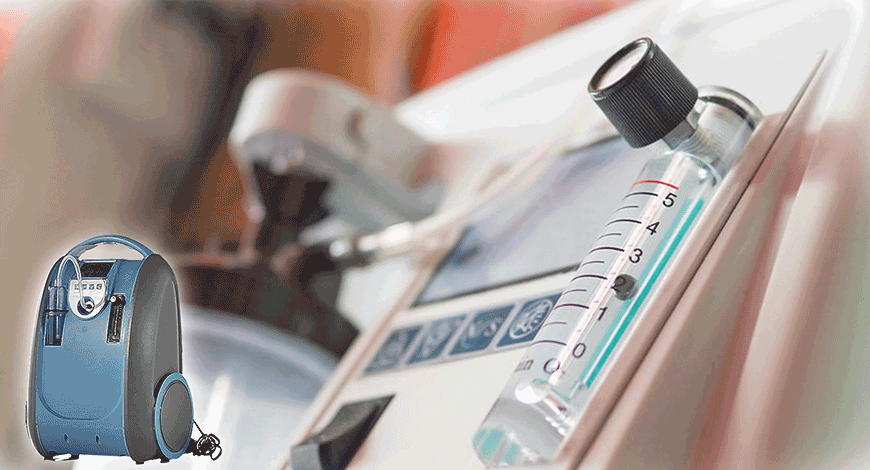Oxygen Concentrators
Room For Both, Stationary And Portable Oxygen Concentrators

The industry is dominated by stationary oxygen concentrators, with high penetration of the devices in the hospital and clinical settings. However, preference is gradually shifting in favor of portable oxygen concentrators.
Among the traditional treatment options for chronic lung diseases, the use of supplemental oxygen at the most severe stage is prescribed near-universally. Although other forms of medication are often used in tandem, inhalers, corticosteroids, and prescription medications, the use of supplemental oxygen has remained a staple in the treatment of lung disease for its ability to provide continuing respiratory support for those who struggle with their oxygen intake on a day-to-day level. Oxygen is an essential medical therapy that has been saving lives for over 100 years.
As one of the most important advances in medical science and technology to this day, the oxygen concentrator is capable of providing a more well-rounded life for individuals plagued by breathing conundrums. The travel opportunities that come along with the use of a portable oxygen concentrator, the home-oriented mobility and independence that comes with the use of a home oxygen concentrator, and the freeing ability to take care of oneself without the restrictions associated with a regular oxygen tank are more than enough to convince anyone of the impressive nature of oxygen concentrators. These products make use of advanced technology lithium rechargeable batteries allowing the patients the freedom to move. These portable oxygen concentrators use pulse flow technology rather than continuous flow technology, which essentially waste oxygen and electricity when not in use. However, the high cost of these concentrators is making it difficult for emerging economies to adopt them at a faster rate.
Future oxygen technologies will continue to be focused on medically accurate and improved oxygen therapy and delivery/recycling methods but also incorporate much more software and intelligence in the design and lighter weight models. In order for companies to drive down costs, more of a focus may also be put on patient maintenance and repair so that parts can be cleaned or replaced easily by the patient and not having to send the unit back and forth to the manufacturer.
Technology trends
There has been a quantum improvement in the oxygen concentrator technology. Less weight and more power are the characteristics of the new portable units that begin to rival larger home units. The huge jump in technology is illustrated by the effectiveness of the new portable equipment. Portable oxygen concentrator technology has been instantiated many times over, but in a most compelling manner now with the new oxygen concentrator equipment representing a technological breakthrough. There has been a complete departure from current mainstream technologies, representing a shift away from standard large, bulky, stationary concentrator systems and inefficient, heavy, and impractical portable equipment.
The explosive growth of portable oxygen has helped redefine the oxygen industry. Not only are patients enjoying a higher quality of life, but also it has helped providers to rethink business and work through some of the cuts, caps, and competitive bidding pervading home healthcare.
The role of innovative, portable oxygen equipment continues to be a central element of long-term oxygen therapy (LTOT). Clinically, improved compliance to therapy in conjunction with increased activity and ambulation has been shown to increase the life expectancy for LTOT patients. Modern LTOT patients are more active and more informed about their choices, as are many of the physicians prescribing oxygen.
Patients who require oxygen therapy are extremely sensitive to the weight of portable oxygen systems, and lighter POCs provide greater patient acceptance. Wearable oxygen concentrators, that weigh less than five pounds, are in the most desirable class. Transportable oxygen concentrators (TOCs) can supply both pulse and continuous oxygen delivery, but they are substantially larger and heavier (by a factor of four to five times) than wearable portable oxygen concentrators. The independence that the portable oxygen concentrator affords the patient is the biggest benefit without worrying about running out of oxygen. Freedom also comes from not waiting for deliveries from the oxygen supplier.
Way forward
Technology can be a boon or it can be a curse. It is up to physicians to master emerging technologies, especially within the realm of respiratory care. Even though portable oxygen concentrator technology is still in its infancy, the market is already seeing significant performance improvements in this category. Portable oxygen concentrator technology is about where laptop computers were five to 10 years ago. If so, the industry is on the verge of a technological explosion in the area of supplemental oxygen that will provide not only more effective devices to meet patients’ needs, but also packaging of these devices in lightweight systems that will stretch battery life beyond current levels. Portable oxygen concentrator technology will not only liberate; it will also enable patients with chronic lung diseases to enjoy a higher quality of life by staying more active. Many feel that increased activity levels, with supplemental oxygen when needed, will go a long way toward minimizing expensive chronic pulmonary disease exacerbations.












